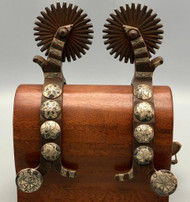Collecting Spurs and 10 Interesting Facts!
Posted by Jim Olson on Jan 5th 2024
"Collecting spurs don’t make you no cowboy!” However, collecting spurs can be a fun and rewarding hobby, enjoyed by thousands of folks. Not only does it provide the opportunity to own exquisite metalwork, but also to own a piece of Western history. The origins of spurs traces its roots back as early as the 5th century BC. These invaluable tools found widespread use among European horsemen during the Middle Ages and virtually every horse culture since, who possessed blacksmithing skills, incorporated spurs into their riding traditions.
The journey of spurs to the North American Continent unfolded in two distinct ways. The British introduced them to the Northeastern region of what is now the United States. But before that, the Spaniards brought them to what is now Florida and the surrounding Islands to the south, and then to "New Spain," which later became Mexico. However, the act of collecting spurs is a relatively recent phenomenon.
This interest was “spurred" on for modern day collectors with the closing of the American Old West era, the rise and popularity of cowboy films during Hollywood's golden age, the proliferation of Western literature and magazines, and the growing acceptance of rodeos and related events as mainstream entertainment. This surge in global popularity transformed the cowboy into an enduring American icon, prompting people to begin collecting items associated with the “Wild West.” The trend took root during the early and mid-1900s, and continues today.
Some spurs carry a substantial price tag and are eagerly sought after by collectors—often taking their place alongside other prized Western memorabilia. Among the most coveted spurs are antique specimens that have withstood the test of time. Those crafted by renowned makers and adorned with silver embellishments, tend to command higher value. Nevertheless, contemporary collectors also covet spurs produced by modern-day artisans. Owning a pair of beautifully crafted spurs by a sought-after maker is considered a badge of honor. In fact, the value of spurs created by prominent modern-day artisans can often rival or surpass that of the antique variety by a famous maker.
Today’s spur collector is a diverse community of folks, ranging from authentic cowboys, Western historians, and individuals from all walks of life with a deep affinity for the cowboy lifestyle. This hobby not only offers an opportunity to connect with the rich history of the American West but also fosters a sense of camaraderie among those who share a passion for these iconic symbols of the Western Frontier.
Here are 10 interesting facts about spurs:
- Ancient Origins: Spurs have a history dating back thousands of years, with their origins traced to the Celts and Romans. They were initially crude metal tools used for horse control.
- Name Sake: This very old word derives from the Anglo-Saxon word spura. The sense of "anything that urges on, or stimulus" is recorded as a meaning of the word in English since ancient times.
- Spreading Across Europe: Spurs gained popularity in Europe during the Middle Ages and were used extensively by European horsemen, contributing to their widespread adoption in equestrian culture that grew far and wide.
- Spanish Influence: The design of the modern Western spur is heavily influenced by Spanish-style spurs, which were brought to the Americas by Spanish conquistadors during the 16th century.
- Materials: Traditionally spurs were made from a variety of materials, including iron, steel, and later, brass, stainless steel and even aluminum.
- Embellishments: Many spurs are decorated with silver, copper or brass in the form of inlay or overlay designs. Jingle-bobs which hang near the rowels and make noise are another popular embellishment.
- Rowel Varieties: Spurs feature a wide range of rowel designs, including everything from blunted rowels to ones with many points. Cloverleaf shaped rowels and silver dollar rowels can even be seen on many a fancy pair of spurs.
- Regional Styles: Different regions developed their own distinct styles of spurs, leading to many variations in design, rowel shapes, and embellishments. California, Texas, Wyoming, Spanish, Mexican, Argentinian and many other regional designs are just a few examples.
- Earning Your Spurs: Medieval Knights were awarded gilded spurs as a badge of honor for bravery or gallantry in the course of duty. This was one of the highest honors bestowed on a Knight. Today, contestants in many equine events are awarded spurs as a trophies — still a badge of high honor.
- Most expensive: If you google “most expensive spurs,” it will show you info. about Victor Wembanyama of the San Antonio Spurs, basketball jersey selling for $762,000. (Ooops.) But to our knowledge, the most expensive pair of Cowboy spurs ever sold at auction was Edward Bohlin’s parade spurs that sold for $235,000 in 2022.
In Conclusion, collecting spurs is not just a hobby, it is a journey through time and an appreciation of craftsmanship. These small metal objects carry the legacy of centuries of horsemanship. Who would have thought that a tool used by horsemen for thousands of years would evolve into a form of metallic art? Those Celtic and Roman blacksmiths would be amazed that the simple, almost crude, forms of spurs they once made would evolve into an art form that now-a-days can sell for many thousands of dollars!
So let’s embark on this fascinating adventure together, where you'll find a world of rich history, camaraderie and discovery. Happy collecting!
Jim Olson © 2024

